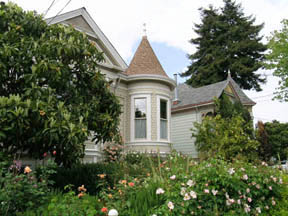



Home
Top 10
By the Numbers
Arguments
News
Contact
Links
Endorsements

December 8: Berkeley's Charm At Risk
As was true in the 1970s, somewhere in Berkeley at some point in the near future, the people of this wonderful community are going to have to draw a line in the sand and insist that enough is enough, that we're not willing to surrender the quality of life we love for some distant developer's new second home. War has been declared on Berkeley's quiet charm. The city/town we know and love is under attack and it will not survive in anything like it's current form if we don't defend it.
From Fred Dodsworth's commentary in the Daily Planet.
Hills Opposition Doomed Measure J
Of all the local measures on this fall's ballot, Measure J was the most hotly contested. Supporters gathered signatures to place it on the ballot after the City Council took steps to change the city's Landmarks Preservation Ordinance.
Most preservationists, including the Berkeley Architectural Heritage Association, supported the measure. The measure was strongly opposed by developers and by the Berkeley Chamber of Commerce. Business for Better Government, the Chamber's PAC, reported spending over $60,000 to defeat the measure.
Exerpt from Rob Wren's 2006 election analysis.
November 7: Measure J Loses
The Alameda County Registrar of Voters reports than Measure J
opponents outnumbered supporters, with 21,869 opposed vs 16,659 in
favor, the second smallest margin in city-wide elections. The bulk of
no votes were recorded in the hills, whereas most yes votes were
tallied in student areas, perhaps reflecting the neighborhoods that
have been most impacted by demolitions to-date. The loss is not
entirely unexpected given a biased and inaccurate City Attorney's
analysis and the Chamber of Commerce PAC's $60,000+ campaign of lies.
September 16: Progressives Endorsement
Berkeley's Progressive Coalition endorses Measure J. This popular
new group promises to give the 60s old-guard, BDC and BCA, a run
for their money in this election and coming years.
September 11: Green Party Endorsement
The Berkeley Green party has endorsed Measure J thanks to
recommendations from City Councilperson Dona Spring, Council Candidate
Merrilie Mitchell, School Board Commissioner John Selawksy, and many
others.
September 5: Analysis Challenge Rejected
Judge Frank Roesch dismissed Laurie Bright's challenge saying that it
was not enough to prove bias but that factual inaccuracy also had to be
proved. While factual inaccuracies were noted in the Petition for Writ
of Mandate they were not made in accordance with legal requirements.
This illustrates how the legal deck is stacked against those alleging
bias in municipal ballot analyses, which are not subject to the same
fair political practice legislation as statewide measures.
August 28: City Analysis Challenged
LPO 2006's Laurie Bright has challenged the City Attorney's biased
ballot analysis of Measure J. A hearing will be held in Superior Court,
Department 31, on September 5th at 2 pm. This Court is in the Oakland
Post Office building at 13th and Jackson St, second floor. Supporters
are encouraged to attend.
See the Daily Planet for details.
August 8: Notes on NIMBYism
Sharon Hudson's insightful look at the social and economic forces
shaping our city, as printed in the Daily Planet.
July 25: Bates' LPO Repeal Tabled
City Council, under threat of a referendum and multiple lawsuits, voted
to table Tom Bates' LPO repeal and rewrite until after the November
elections.
July 3: Approved by Registrar of Voters
Sherry Kelley from the City Clerk's office has confirmed that the 3200 signatures submitted for LPO2006 have qualified our initiative for the November ballot.
June 28: Taming the Teardown Trend
Taming the Teardown Trend - a speech by Richard Moe of the National
Trust. Given to the California Commonwealth Club on June 28th:
1 hour realaudio
June 26: Daily Cal
The Berkeley Landmarks Preservation Initiative is a response to the corporate welfare policies of Mayor Tom Bates. It was created after negotiations between citizens, neighborhood associations, Landmarks Commissioners, and the Mayor broke down. At the single public hearing on this issue, held on February 14th (available in streaming video at (www.ci.berkeley.ca.us/citycouncil/agendaindex.htm), residents supporting the Landmarks Preservation Ordinance (LPO) outnumbered those opposed by 40 to 1. Five non-residents spoke in favor of the Mayor's proposal, all were developers or their employees. After the hearing it was obvious that public opinion would have no influence on the Mayor or Councilpersons Capitelli and Moore and there were no remaining options other than a public election. In just 3 weeks over 3,000 residents signed the petition to put the Landmarks Preservation Initiative on the November ballot.
November's Landmarks Preservation Initiative is nearly identical to the existing LPO with the addition of updates from the State Office of Historic Preservation, The State has certified our LPO as being in full compliance with California law. The LPO was originally enacted by the City Council in 1974 after voters approved the Neighborhood Preservation Ordinance with the goal of protecting affordable housing, saving the City's most valuable historic buildings from demolition, and protecting neighborhoods from the "redevelopment" trend of the 60s. This redevelopment, best detailed in Jane Jacobs' "The Life and Death of Great American Cities", fueled many unfortunate urban trends including neighborhood blight, rising crime rates, and suburban flight. The LPO effectively stopped this in Berkeley and has saved over 300 buildings during the past 32 years with few controversies. But that hasn't stopped Mayor Bates.
Mayor Bates' revisions have two goals: 1) to make it easier for commercial developers and speculators to tear down historically significant buildings and 2) to diminish the ability of the Landmarks Commission and citizens to have a voice in the process. Because there is little in Bates' proposal that would help homeowners or small businesses, the main beneficiaries would be large scale developers seeking demolition permits where neighborhood opposition is expected. This is very much a City Hall vs. neighborhoods issue and, not surprisingly, the Mayor has received no support from any of the City's seventy neighborhood associations.
When Tom Bates ran for Mayor four years ago, big real estate was his most significant source of campaign donations. Not surprisingly, he has spent most of his subsequent time in office making Berkeley developer-friendly. His efforts have resulted in fundamental changes in a number of departments and commissions, particularly the Planning and Development Department, which now acts more like a redevelopment agency. The old redevelopment myths of the 60s are also being floated once again, particularly the idea that it provides "affordable housing."
Everyone agrees that Berkeley needs affordable housing to protect diversity, however, even the sub-market rate units being built are priced well above current rents. Those rents are set for people earning 80% of the median income or $1,116 for a one bedroom apartment. Since the vacancy rate is higher than it has been for decades this is well over current rents. So not only are affordable units not being built but the millions of dollars in subsidies needed to incentivize developers (corporate welfare) come out of other City services including road maintenance, police, and fire services.
Another old redevelopment myth is that historic preservation is "anti-development." While this might be an effective way to solicit campaign contributions it is far from the truth. There are over 1500 new units coming on the market in Berkeley - far, far more than any other city our size. The LPO is not about development, it is about demolition and only about the demolition of historic buildings. What the LPO does is focus development where it is most appropriate: blighted lots, transit corridors, and outside of historic neighborhoods.
Is preservation controversial? For the vast majority of Berkeley's Landmarks the answer is no. To be sure there are structures like Celia's and Brennan's whose landmark designation was opposed by many. But these buildings also have many supporters. However, most controversial decisions have been, and will continue to be, decided in favor of developers. Despite this some developers continue to characterize the LPO and Landmarks Commission as anti-development.
When a developer disagrees with a Commission's or citizen's landmark designation they can appeal to the City Council. The current Council is one of the most developer-friendly in the City's history, and has struck down landmark designations despite overwhelming neighborhood opposition. This type of appeal is part of the democratic process, however, all effected parties should be fairly considered. Public input is essential and important decisions should not be made strictly by staff in City Hall. November's Landmarks Preservation Initiative will protect these democratic principles.
More information can be found on the LPO Initiative's website at www.lpo2006.org.
June 6: Press Release
A grassroots solution to Berkeley's long debated Landmarks Preservation Ordinance (LPO) will soon be decided by the voters. Backers turned in over 3000 signatures Monday, 150% of the number required to qualify.
Proponents of the initiative cite strong support from neighborhood associations and last February's public hearing, where supporters outnumbered opponents by 5 to 1, as their motivation for taking the issue out of City Hall and to the public.
The LPO initiative preserves protections in the existing ordinance which is credited with saving over 300 historic buildings since it was created in 1974. It adds several changes recommended by California's Office of Historic Preservation but otherwise leaves the time-tested LPO unchanged. It differs from previous proposals which would limit the Landmarks Commission and public participation in favor of administrative decisions made by Planning Department staff.